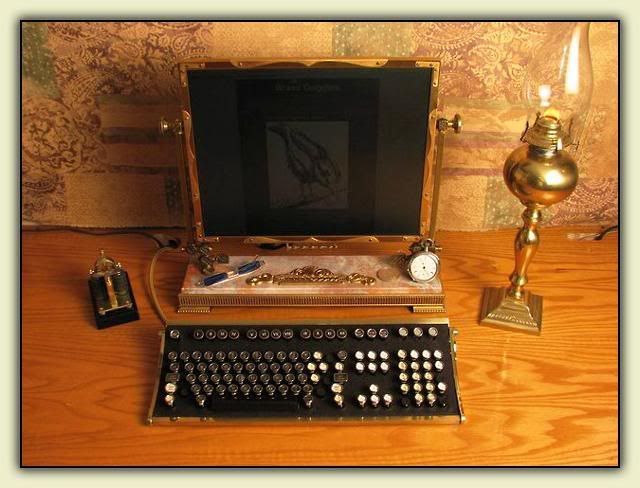No, I’m not talking about a couple of beefcake medicos from “Grey’s Anatomy.”
I’m talking about Steampunk, that peculiar literary and artistic genre that conflates the Victorian/Edwardian Age of Steam aesthetic with anachronistic technology. I first came into contact with it when I read J. W. Jeter’s Morlock Night back in 1979. Jeter, in fact, coined the term “steampunk,” and he is widely credited with establishing the genre with that novel, but perhaps the best example of the type is The Difference Engine by William Gibson and Bruce Sterling. Gibson (who invented the word “cyberspace”) and Sterling, both of whom had been pioneers in the so-called cyberpunk arena, set their story in an alternative world in which Charles Babbage’s steam-driven “difference engine,” a mechanical computer, brought the Information Revolution smack-dab into the middle of the Steam Age.
It made for an interesting story, but it also inspired many other writers to create their own strange worlds, worlds in which electricity played a minor role (and electronics a nonexistent one), replaced by steam and clockwork. Sometimes their stories were set in Victorian times, sometimes even earlier. And some stories incorporated fantasy elements to varying degrees. Thus, graphic novel opuses such as The League of Extraordinary Gentlemen, set in the late 19th century, full of anachronistic clockwork technology, and populated with characters from miscellaneous literary fiction: Captain Nemo, the Invisible Man, Allan Quatermain, Dr, Jekyll, et al. Or bizarre pastiches such as “The Amazing Screw-On Head.”
Ya gotta love “The Amazing Screw-On Head.” Airships, machine guns, werewolves, robots, a Zombie Villain, alien demi-gods...and Abe Lincoln. “I’m so excited, I just made water in my pantaloons!”
[You could even make the case that a film like Sky Captain and the World of Tomorrow is a variant of steampunk. Dieselpunk, perhaps?]
Steampunk comes alive in worlds of polished wood, brass, copper, and crystal rather than plastic. Some people have taken it farther than simply writing about these worlds. They have begun dressing the part...and transforming objects so that they fit within the steampunk aesthetic.
Take a look at this clockworky item here, for example.

Image: Richard Nagy.
With its elegant wood case, brass mechanism, and winding key, one could easily mistake it for a music box. But no:

Image: Richard Nagy.
It’s a frickin’ Lap-Top Size Computational Engine! Just insert the key and turn it on.
This little gem was created by one Richard Nagy, AKA the Datamancer, whose work was among several imaginative steampunk creations showcased recently at Newsweek.com. Another mad genius is Sean Slattery, AKA Hieronymus Isambard “Jake” von Slatt, who operates a site called The Steampunk Workshop. Jake does a lot of interesting arty stuff with dangerous chemicals - I like this guy already! - but that’s just part of the picture. He also likes to tinker with computer components, converting them into brass, wood, and copper masterpieces that look like they were built rather than pooped out of a mold.
Check this out:

Image: Sean Slattery.
This keyboard was created by laboriously attaching vintage typewriter keys to a “vintage” IBM keyboard and setting the whole into a handcrafted brass frame. Jake has complete details - including video - at his site, in case you want to make your own. Here’s a closer look, showing the brass frame:

Image: Sean Slattery.
And as if that were not enough, check out the flat-screen Image Display, appropriately ’punked up:

Image: Sean Slattery.
Perfect forblogging inscribing Interconnected World Wide Web-Logs back in the Gaslight Era.
Damn! I want me one of these! And now, I must needs go take a bit of snuff.
[Tip o’ th’ Elisson fedora to Velociman, who sent me the link to Jake’s amazing site.]
I’m talking about Steampunk, that peculiar literary and artistic genre that conflates the Victorian/Edwardian Age of Steam aesthetic with anachronistic technology. I first came into contact with it when I read J. W. Jeter’s Morlock Night back in 1979. Jeter, in fact, coined the term “steampunk,” and he is widely credited with establishing the genre with that novel, but perhaps the best example of the type is The Difference Engine by William Gibson and Bruce Sterling. Gibson (who invented the word “cyberspace”) and Sterling, both of whom had been pioneers in the so-called cyberpunk arena, set their story in an alternative world in which Charles Babbage’s steam-driven “difference engine,” a mechanical computer, brought the Information Revolution smack-dab into the middle of the Steam Age.
It made for an interesting story, but it also inspired many other writers to create their own strange worlds, worlds in which electricity played a minor role (and electronics a nonexistent one), replaced by steam and clockwork. Sometimes their stories were set in Victorian times, sometimes even earlier. And some stories incorporated fantasy elements to varying degrees. Thus, graphic novel opuses such as The League of Extraordinary Gentlemen, set in the late 19th century, full of anachronistic clockwork technology, and populated with characters from miscellaneous literary fiction: Captain Nemo, the Invisible Man, Allan Quatermain, Dr, Jekyll, et al. Or bizarre pastiches such as “The Amazing Screw-On Head.”
Ya gotta love “The Amazing Screw-On Head.” Airships, machine guns, werewolves, robots, a Zombie Villain, alien demi-gods...and Abe Lincoln. “I’m so excited, I just made water in my pantaloons!”
[You could even make the case that a film like Sky Captain and the World of Tomorrow is a variant of steampunk. Dieselpunk, perhaps?]
Steampunk comes alive in worlds of polished wood, brass, copper, and crystal rather than plastic. Some people have taken it farther than simply writing about these worlds. They have begun dressing the part...and transforming objects so that they fit within the steampunk aesthetic.
Take a look at this clockworky item here, for example.

Image: Richard Nagy.
With its elegant wood case, brass mechanism, and winding key, one could easily mistake it for a music box. But no:

Image: Richard Nagy.
It’s a frickin’ Lap-Top Size Computational Engine! Just insert the key and turn it on.
This little gem was created by one Richard Nagy, AKA the Datamancer, whose work was among several imaginative steampunk creations showcased recently at Newsweek.com. Another mad genius is Sean Slattery, AKA Hieronymus Isambard “Jake” von Slatt, who operates a site called The Steampunk Workshop. Jake does a lot of interesting arty stuff with dangerous chemicals - I like this guy already! - but that’s just part of the picture. He also likes to tinker with computer components, converting them into brass, wood, and copper masterpieces that look like they were built rather than pooped out of a mold.
Check this out:

Image: Sean Slattery.
This keyboard was created by laboriously attaching vintage typewriter keys to a “vintage” IBM keyboard and setting the whole into a handcrafted brass frame. Jake has complete details - including video - at his site, in case you want to make your own. Here’s a closer look, showing the brass frame:

Image: Sean Slattery.
And as if that were not enough, check out the flat-screen Image Display, appropriately ’punked up:

Image: Sean Slattery.
Perfect for
Damn! I want me one of these! And now, I must needs go take a bit of snuff.
[Tip o’ th’ Elisson fedora to Velociman, who sent me the link to Jake’s amazing site.]


















No comments:
Post a Comment